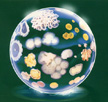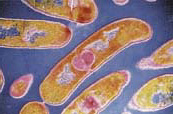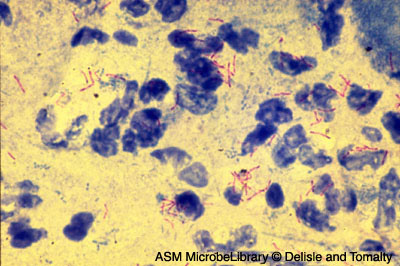
 |
Todar's Online Textbook of Bacteriology |
© 2008 Kenneth Todar University of Wisconsin-Madison Department of Bacteriology
Endospore-forming bacteria
Endospore-forming bacteria produce a unique resting cell called an endospore. They are Gram-positive and usually rod-shaped, but there are exceptions. The two medically-important genera are Bacillus, the members of which are aerobic sporeformers in the soils, and Clostridium, whose species are anaerobic sporeformers of soils, sediments and the intestinal tracts of animals.

Figure 10. Endospore-forming bacilli (phase
contrast illumination). Endospores are dehydrated, refractile cells appearing as
points of bright light under phase microscopy. Endospore-forming bacteria are
characterized by the location (position) of the endospore in the mother cell
(sporangium) before its release. The spore may be central, terminal or
subterminal, and the sporangium may or may not be swollen to accommodate the
spore.
Some sporeformers are pathogens of animals, usually due to the production of powerful toxins. Bacillus anthracis causes anthrax, a disease of domestic animals (cattle, sheep, etc.), which may be transmitted to humans. Bacillus cereus causes food poisoning. Clostridium botulimum causes botulism, a form of food poisoning, and Clostridium tetani is the agent of tetanus. Clostridium perfringens causes food poisoning, anaerobic wound infections and gas gangrene, and Clostridium difficile causes a severe form of colitis called pseudomembranous colitis. Whenever the spore-formers act as pathogens, it is not uncommon or surprising that their spores are somehow involved in transmission or survival of the organism between hosts.

Figure 11. Robert Koch's original
photomicrographs of Bacillus anthracis. In 1876, Koch established by
careful microscopy that the bacterium was always present in the blood of animals
that died of anthrax. He took a small amount of blood from such an animal and
injected it into a healthy mouse, which subsequently became diseased and died.
He took blood from that mouse and injected it into a another healthy mouse.
After repeating this several times he was able to recover the original anthrax
organism from the dead mouse, demonstrating for the first time that a specific
bacterium is the cause of a specific disease. In so doing, he established Koch's
Postulates, which still today supply the microbiological standard to demonstrate
that a specific microbe is the cause of a specific disease.
Listeria monocytogenes is a Gram-positive rod-shaped bacterium related to Bacillus and Clostridium, but it does not form endospores. Listeria monocytogenes is the agent of listeriosis, a serious infection caused by eating food contaminated with the bacteria. Listeriosis has recently been recognized as an important public health problem in the United States. The disease affects primarily pregnant women, newborns, and adults with weakened immune systems.

Figure 12. Listeria monocytogenes.
Transmission EM.
Actinomycetes and related bacteria
The actinomycetes are not thought of as pathogenic bacteria, but two of their relatives are among the most important pathogens of humans, these being the agents of tuberculosis and diphtheria. Actinomycetes are a large group of Gram-positive bacteria that usually grow by filament formation, or at least show a tendency towards branching and filament formation. Many of the organisms can form resting structures called spores, but they are not the same as endospores. Branched forms superficially resemble molds and are a striking example of convergent evolution of a procaryote and a eucaryote together in the soil habitat. Actinomycetes such as Streptomyces have a world-wide distribution in soils. They are important in aerobic decomposition of organic compounds and have an important role in biodegradation and the carbon cycle. Actinomycetes are the main producers of antibiotics in industrial settings, being the source of most tetracyclines, macrolides (e.g. erythromycin), and aminoglycosides (e.g. streptomycin, gentamicin, etc.).
Two genera of bacteria that are related to the actinomycetes, Corynebacterium and Mycobacterium, contain important pathogens of humans: Otherwise, many nonpathogenic mycobacteria and corynebacteria live in normal associations with animals.
Mycobacterium tuberculosis is the etiologic agent of tuberculosis (TB) in humans. Tuberculosis is the leading cause of death in the world from a single infectious disease. Mycobacterium tuberculosis infects 1.7 billion people/year which is equal to 33% of the entire world population. The bacterium is responsible for over 3 million deaths/year. After a century of decline in the United States, cases of tuberculosis have increased slightly, and multiple drug-resistant strains have emerged, This increase in cases is attributable to changes in the social structure in cities, the HIV epidemic, and patient failure to comply with treatment programs. A related organism, Mycobacterium leprae, causes leprosy.

Figure 13. Mycobacterium tuberculosis
Acid-fast stain. 1000X magnification. © Gloria J. Delisle and Lewis Tomalty,
Queens University, Kingston, Ontario, Canada. Licensed for use by ASM Microbe
Library
http://www.microbelibrary.org.These bacteria were observed in a
sputum sample from a patient with active tuberculosis.
The genus Corynebacterium consists of a diverse group of bacteria including animal and plant pathogens, as well as saprophytes. Some corynebacteria are part of the normal flora of humans, finding a suitable niche in virtually every anatomic site. The best known and most widely studied species is Corynebacterium diphtheriae, the causal agent of diphtheria. The study of Corynebacterium diphtheriae traces closely the development of medical microbiology, immunology and molecular biology. Many contributions to these fields, as well as to our understanding of host-bacterial interactions, have been made studying diphtheria and the diphtheria toxin.